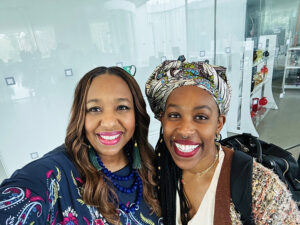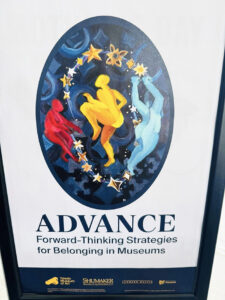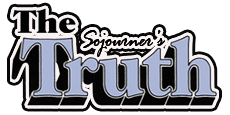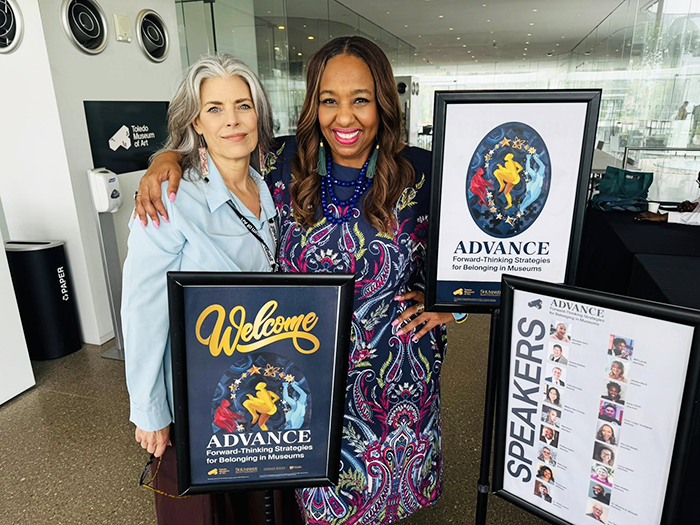
By Asia Nail
The Truth Reporter
The air was still buzzing.
When I called Rhonda Sewell, director of Advocacy and External Affairs at the Toledo Museum of Art, I could hear the excitement in her voice. She had just helped lead a three-day event that, in many ways, felt like history in the making.
“Hi Rhonda, thank you so much for taking the time to speak with me today,” I said.
Then I said thank you for something much bigger—“thank you for helping the world remember how to hope.”
In a time when museums across the country are shrinking back from diversity work, the Toledo Museum of Art did the opposite. They leaned in. Quietly, boldly, beautifully.
They hosted the Inaugural Belonging Symposium, a powerful gathering full of rhythm, reflection and real talk. Nearly 200 people came in person and online.
Over three days and two nights, they filled the museum with laughter, note-taking, honest tears and moments that made hearts shift. It was a space where people from all walks of life came to talk about one thing: what it means to truly belong.
Why Now? Because the World Needs It
This event wasn’t a quick reaction. It was a full year in the making.
“It was always a dream of mine,” said Sewell. “When I was hired as director of Belonging, I told our director, Dr. Adam Levine, I’d love to someday host a symposium like this. When the moment came, he said yes—and trusted us with the vision.”
That kind of leadership, she says, is rare. And it’s exactly what made the event feel safe and sacred. Sewell co-led the project with Libbey Koppinger, Development Operations coordinator, and together, with their “Agile team” of planners from across the Museum, they made it happen.
 The theme was ADVANCE: Forward-Thinking Strategies for Belonging in Museums, but the ideas stretched far beyond gallery walls.
The theme was ADVANCE: Forward-Thinking Strategies for Belonging in Museums, but the ideas stretched far beyond gallery walls.
“You don’t have to work in a museum to take something away from this,” Sewell said. “It was built for everyone.”
And everyone came.
Stars, Ropes and the Rhythm of Belonging
One of the most powerful parts of the symposium was the art—especially a painting by Faith Goodman, a local artist and TMA staff member. Her piece, Stardust Dutch, felt like a visual heartbeat of the entire event.
It showed faceless human figures playing double Dutch in the stars.
Why double Dutch? “Because it’s a game you can’t play alone,” Goodman explained in her artist statement.
“It takes timing, rhythm, teamwork—and trust.”
The jumpers stretch toward the stars, symbolizing what we can achieve when we collaborate. The image made people pause. Some stood still, others whispered but all felt its power.
“It’s this cosmic dance,” said Sewell, “and it reminded all of us that belonging doesn’t come from one person. It’s something we build together.”
Voices of Commitment
That spirit of collaboration isn’t just reflected in the artwork—it’s woven into the very identity of the Toledo Museum of Art.
“This event aligns with who we are—our values and our strategic goals: to be a model museum, known for our commitment to quality and for fostering a true culture of belonging,” said Rhonda Sewell.
She explains that the Museum’s dedication to belonging is grounded in more than just good intentions—it’s rooted in values chosen collectively by the staff.
“We have four values that align with a symposium like this,” she said. “Our entire staff selected them about five years ago when new leadership came in. These values—community, innovation, trust and diversity—guide everything we do.”
Leading with Access
TMA isn’t just talking about inclusion, either; they’re making it happen. They were the first major museum in the country to have a Manager of Access Initiatives. This role ensures that everyone, regardless of ability, can enjoy the museum’s offerings.
Katie Shelley, who holds this position, brings personal experience to her role. Living with a disability and accompanied by her service dog, Petunia, she ensures that accessibility is at the forefront of TMA’s mission.
A Community United
TMA’s efforts are resonating. Visitors from all walks of life are finding a place where they belong. The museum’s outreach programs have increased local engagement, and their exhibitions are more representative of wide-ranging cultures and histories.
Sewell reflects on the broader impact:
“In the museum field, access is often lacking. Here at the Toledo Museum of Art, we use the term DEAI—diversity, equity, access, and inclusion—though most people know it as DEI. We see what’s happening across the country; we read the news like everyone else. But for us, this is about a core value system—something we live out as an anchor institution in the Toledo area, recently voted the best art museum in the country by USA Today.”
At the heart of the museum’s success is a leadership style as rare as it is effective. Instead of relying on top-down decision-making, TMA runs on collaboration—and it shows.
“We have an agile leadership model where internal members from various departments come together to plan all kinds of things—from construction projects to creating documentaries,” says Sewell.
“The staff powers this museum.”
That staff-driven approach isn’t just a trendy leadership buzzword—it’s baked into the culture. Everyone has a seat at the table. Everyone has a voice. And that’s not something you see every day.
“It’s very staff-driven and non-hierarchical, which is uncommon,” Sewell added.
“We’re unlike a lot of organizations—period. Not just museums, but period.”
That kind of culture doesn’t go unnoticed and in fact, it may be a big reason TMA was recently voted the best in the country
A Plan with Power—and Proof
At the Toledo Museum of Art, belonging isn’t just a feeling. It’s a plan. A real, measurable, written-down plan that they update, live by, and hold themselves accountable to.
The 2025 Belonging Plan outlines big goals and even bigger actions. And the results? Speak for themselves.
Just a few years ago, only six percent of museum visitors came from the surrounding two-mile neighborhood, an area with some of Toledo’s lowest-income communities. Today, that number is nearly 18 percent, and total attendance has grown by over 40 percent.
How? They removed barriers—starting with parking. “As of January, it’s free to park at the Museum forever,” Rhonda shared. “It was $10 before. That’s a barrier for a lot of families. Not anymore.”
The Belonging Plan focuses on four major goals:
- Active Outreach and Engagement
- Broaden the Narrative of Art History
- Become an Employer of Choice
- Create a Platform for Operational Excellence
From hiring diverse curators to collecting art that reflects different cultures, to making physical and digital exhibits more accessible—TMA is showing other institutions how to lead with both heart and backbone.
You can read the entire Belonging Plan here: Belonging at TMA
Soul-Stirring Speeches and Standing Ovations
If there was one moment that cracked everyone wide open, it was the keynote from Maurice Stinnett, EdD. He’s led DEI efforts at Warner Music, for the NBA’s Brooklyn Nets, and even served under President Obama.
His talk? “Are Organizations Truly Committed to Belonging?”
But instead of pointing fingers, he turned the question inward. “You are the organization,” he said. “You have the power to change things.”
The room was electric. There were tears. A standing ovation. Sewell called it “soul-stirring,” and said his words hit people like a sermon, a mirror, and a rally cry all in one.
Later that day, a panel titled “Where Do We Go From Here?” brought together voices from across the country.
Bee Davis, a Black trans NASA engineer. Roberto Bedoya, a Latinx elder known as the “Godfather of Belonging.” Tim Tegge, a visually impaired executive for The Sight Center of Northwest Ohio. And Priya Frank, East Indian racial equity and strategy consultant. The panel was led by local HR leader and TMA board member Rodney Eason.
They didn’t just speak. They shared. Deeply. Honestly. Powerfully.
Watch It Again. Or For the First Time.
Couldn’t make it to the event? No worries.
The entire Belonging Symposium—featuring nearly 200 participants and an incredible lineup of national and local speakers, artists, scholars, and advocates—was filmed in full. It will soon be available to watch on the Toledo Museum of Art’s YouTube channel, giving viewers everywhere the chance to experience the powerful keynotes, panel discussions, and shared strategies that made this historic event so impactful.
That kind of access—offering deep, meaningful content for free to the public—fits the spirit of the symposium perfectly.
It was never about gatekeeping. It was always about gathering.
The Museum That Walks the Talk
Adam Levine, D.Phil, the Museum’s director and CEO, said it best in his letter inside the Belonging Plan:
“If we do this right, people won’t just come for a program or event. They’ll come back again and again—because they feel at home.”
And they do.
Because this isn’t a museum that’s quietly hanging pretty pictures. It’s a museum that’s inviting people in and listening when they speak. That’s turning strategy into stories and stories into change.
For the Ones Who Feel Like They Don’t Belong
Before we ended our call, I asked Rhonda one last thing.
“What would you say to someone reading this who feels like they don’t belong anywhere?”
Her voice softened.
“I’d tell them—come visit us. Come to the Museum. No cost. No pressure. Just come walk through. Sit. Breathe. Look. We’ll greet you. We’ll guide you. You belong here.”
And I believe her.
Because in a world that often tells people they don’t fit, TMA is a place that says—you do.
To learn more about the museum’s Belonging Plan and initiatives, visit toledomuseum.org.
Free admission. Free parking. All are welcome.

